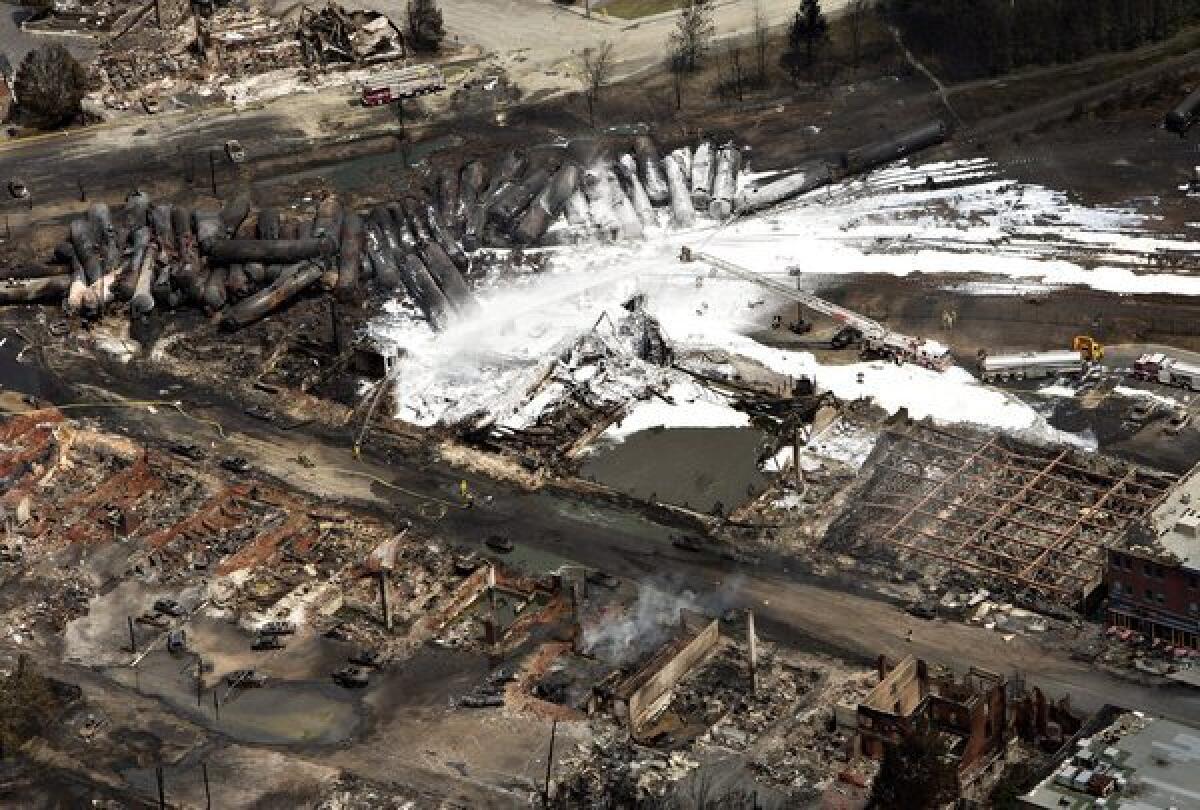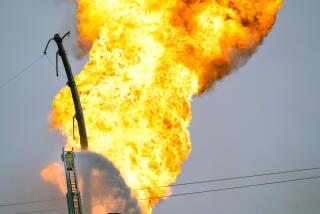Canada rail crash stirs debate over Keystone XL pipeline delay

- Share via
As Canadian investigators sift through the gruesome wreckage of an oil train derailment and explosion in Lac Megantic, Quebec, the deadly crash has intensified a debate among environmentalists and energy-independence advocates as to whether it is safer to ship oil by rail or by pipeline.
The circuitous route the oil involved in the accident was taking to its ultimate destination – U.S. consumers – also illustrates the conundrum faced by North American producers eager to get their crude oil to a far-flung network of specialized refineries within easy onward delivery range of the intended markets.
All but one of 73 rail tanker cars on the runaway Montreal, Maine & Atlantic Railway train that crashed Saturday were carrying crude oil from the Bakken fields in North Dakota to a refinery in St. John, New Brunswick, calibrated to handle that particular type of crude.
The train had been left unattended during a stop six miles from the crash site and had been boarded by firefighters summoned to extinguish an onboard blaze five minutes after the sole engineer set the brakes and left it unmanned. Authorities said this week that at least 50 people were presumed dead in the crash and explosions.
Whether Canada’s deadliest train disaster in more than a century was the result of human error or equipment failure remains to be determined. But the accident has supporters of the stalled Keystone XL pipeline project brandishing statistics that purport to show a superior safety record of pumped oil shipment over that carried by rail.
Railway carriage of oil in North America has more than doubled in the last year as plans for the 1,700-mile Alberta-to-Texas pipeline have hit a wall of environmental protest and doubt about the predicted economic boon for the U.S. economy.
U.S. government approval of the Keystone XL pipeline is on hold after the Environmental Protection Agency in April took issue with a State Department review that concluded that the tar-like oil from the Alberta sands that would be transported by the pipeline emits 17% more greenhouse gases than conventional crude oil. The EPA has insisted that the excess tar sands emissions, from extraction to automobile exhaust, would be much more than 17%.
Keystone is a priority project for Canada and the pipeline developers, TransCanada Corp., because only 4% of the country’s 170 billion barrels of proven reserves of oil sands crude has been developed. All but 1.5% of what little is extracted is sold to the United States at a considerable discount from global prices. Canada wants the pipeline to the Texas Gulf Coast refineries so it can ship more of its production to more lucrative foreign markets.
As the pipeline project idles, crude oil extractors have turned increasingly to the railroads to get their product to a complex network of North American refineries. Trains hauled a record 97,000-plus tankers of crude oil in the first quarter of this year, up 166% from the same period in 2012 and nine times what was delivered by rail five years ago, the Assn. of American Railroads reports.
What the Lac Megantic disaster demonstrates, Keystone backers were quick to claim, is that the rapidly expanding rail carriage poses more risk to human life and the environment than would the pipeline. And without Keystone, designed to handle 830,000 barrels a day, rail shipment of Canadian crude will continue to expand at breakneck speed to tap the Alberta bounty while global oil prices are riding high, industry analysts forecast.
Trains haul oil tankers through U.S. towns and cities every day and the Quebec disaster shows “why pipelines are safer and environmental opposition to a pipeline from Canada is misguided,” Investors’ Business Daily declared in an editorial Tuesday.
“The evidence is so overwhelming that railroads are far less safe than pipelines,” the newspaper, which has backed the Keystone project, quoted Brookings Institution energy security initiative director Charles Ebinger as saying.
One day after the Quebec disaster, Diana Furchtgott-Roth of the conservative Manhattan Institute for Policy Research, penned a commentary for Canada’s Globe and Mail newspaper reiterating the findings of her June study that oil spills are twice as frequent from trains as from pipelines.
“It is time to speed up the approval of new pipeline construction in North America,” wrote Furchtgott-Roth. “Pipelines are the safest way of transporting oil and natural gas, and we need more of them, without delay.”
The Assn. of American Railways concedes that trains spill 2.7 times more oil than pipelines. But the industry group and other sources note that pipeline accidents tend to be bigger and more costly in terms of cleanup and environmental damage than rail mishaps.
“All methods of transporting oil have risks. And there are lots of different kinds of accidents – this train didn’t have its brakes on and rolled into a town, which is very different from an oil spill into a wildlife refuge. How you compare those things is not simple,” Jonathan Koomey, a research fellow at Stanford University’s Steyer-Taylor Center for Energy Policy and Finance, said in an interview.
Pipelines are cheaper to build and operate than are new railroad networks, and pipeline accidents are less frequent, Koomey said. But he sees the environmentalist opposition to Keystone as more of a tactical campaign in the fight against global warming than a strict risk and cost analysis. Stalling the pipeline forces oil extractors to look to rail for more capacity, and the expense and time involved to achieve that expansion puts pressure on the industry to reduce extraction, and by extension the higher emissions of greenhouse gases from the tar sands crude.
“The argument comes from an understanding that there is a fixed amount of carbon that we can emit and stay under the two degrees of warming,” Koomey said. He was referring to what scientists have calculated as the increase in the temperature of Earth’s atmosphere that would cause irreparable damage from melting Arctic ice and flooding lowlands.
“For the most part, transportation by rail is safe,” Michael Whatley, executive vice president of the industry-backed and pro-Keystone Consumer Energy Alliance, said in an interview with the Energy Wire news service. Speaking of the Lac Megantic disaster, he said, “We don’t need an overreaction that’s going to restrict rail access. ... I don’t want to punch the safety record of rails, because they’ve got a great record, but pipelines are safest.”
ALSO:
Egyptian army defends role in Cairo protest deaths
War crimes court restores genocide charge against Karadzic
Nelson Mandela’s controversial king takes on South Africa’s president
A foreign correspondent for 25 years, Carol J. Williams traveled to and reported from more than 80 countries in Europe, Asia, the Middle East and Latin America.
More to Read
Sign up for Essential California
The most important California stories and recommendations in your inbox every morning.
You may occasionally receive promotional content from the Los Angeles Times.











